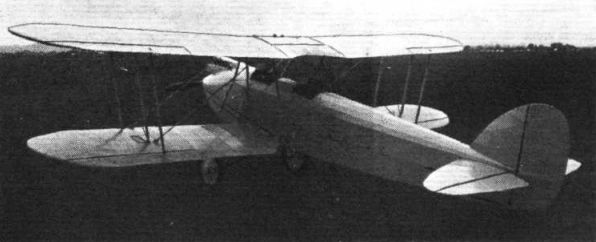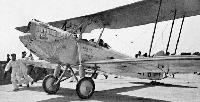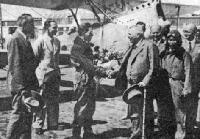
Варианты
- Ishikawajima - R-3 - 1930 - Япония
- Ishikawajima - R-5 - 1933 - Япония
- Tachikawa - KKY - 1935 - Япония
Flight, July 1931
A JAPANESE LIGHT AIRCRAFT
THE Ishikawajima Aircraft Company have produced a two-seater single bay light aircraft somewhat reminiscent of the Moth and Avian called the R.3. This will be fitted with either the Cirrus III or Hermes II engines, for both of which the same Company hold the manufacturing rights.
The chief designer, who is Mr. Yoshihara, claims that particular attention has been paid to high factors of safety, performance, exceptional flying qualities and low maintenance costs.
The machine is said to possess remarkable manoeuvrability, while the controls are so effective that any type of aerobatic evolution can be managed with ease. The take-off has received particular attention, since in Japan, landing fields, when existent at all, are of a very limited size.
During the next Spring the Tokio Student Union have arranged to send someone on a production model R.3 to Europe via Siberia. The proposed route being from Tokio via Siberia to Poland, Berlin, Brussels, London, Berlin and finishing in Rome.
Constructional Details. - The fuselage is built up of welded steel tubing and is wire braced, particular care having been taken that both pilot and passenger have ample cockpit space together with exceptional leg room. The engine mounting is attached to the fuselage by four bolts only, and is built up from Duralumin channels reinforced by a curved Duralumin plate underneath the engine, which also serves as cowling. The wings are all wood construction, with a three-ply leading edge, and are fabric-covered. The spars are all boxed spruce and three-ply. The ply leading edge is somewhat different to that usually used in this country, since it is also extended back underneath the wing to the bottom of the rear spar with fabric over it.
A patent held by the Ishikawajima Aircraft Co. also arranges that the aileron hinge points are fitted in such a manner which it is claimed, compensates for yaw and reduces rudder movement necessary in turning. The ailerons themselves are very light and are constructed of duralumin channel. The interplane struts are streamline steel tubing.
All tail surfaces are similarly constructed of Duralumin channel, and, though very light, are extremely rigid and well braced by tubular steel struts of streamline cross section. The landing gear uses oil and rubber discs in compression for shock absorbtion, and is of the open type without a cross axle. The tail skid is steerable and sprung with rubber discs in compression. The fuel supply is direct by gravity from two 14-gall. tanks of aluminium in the upper centre section.
- Flight, July 1931
A JAPANESE LIGHT AIRCRAFT
Фотографии
-
Aviation Historian 14 / P.Thompson - Young Japan
Регистрационный номер: J-BEPB [11] The fuselage of the R-3 was doped silver fabric, overlaid with grey-blue decking from aft of the engine to the tail. Japan’s national hinomaru (‘‘circle of the sun”) with two grey-blue bars was applied to the fuselage and under the wings. The kanji symbols beneath the cockpit read Seinen Nippon, and the characters on the fin read Giyu (“loyalty and courage”) No 10.
-
Flight 1931-07 / Flight
The clean lines of the Ishikawajima R3 make it look attractive and presage a good performance.
-
Flight 1931-01 / Flight
THE "CIRRUS" IN JAPAN: The Ishikawajima training biplane, which, as mentioned in Croydon Notes recently, is now being fitted with "Hermes II" engines
-
Aviation Historian 14 / P.Thompson - Young Japan
Регистрационный номер: J-BEPB [11] A rare air-to-air photograph of Seinen Nippon in flight. The R-3’s wings - with spars of boxed spruce and three-ply - were of all-wood construction with a three-ply leading edge and were fabric-covered. The aileron hinge points were fitted, so Ishikawajima claimed, to compensate for yaw, thus reducing rudder work for the pilot.
-
Aviation Historian 14 / P.Thompson - Young Japan
Регистрационный номер: J-BEPB [11] One of the six R-3s built, J-BEPB was delivered to Hosei University in March 1931. Stressed for aerobatics, the R-3 was very much the Japanese equivalent of the British D.H.60 Moth, although the military rejected the type as a primary trainer, mainly owing to its troublesome licence-built Cirrus engine.
-
Aviation Historian 14 / P.Thompson - Young Japan
Регистрационный номер: J-BEPB [11] With the first leg from Tokyo completed in exactly four hours, a gleaming Seinen Nippon arrives at Osaka-Tatetsu airfield on May 29, 1931. The following day the pair were to fly over the Sea of Japan, considered a brave undertaking in a light aircraft at the time.
-
Aviation Historian 14 / P.Thompson - Young Japan
Регистрационный номер: J-BEPB [11] The pair arrive at a destination on the Korean or Chinese part of their epic journey. The R-3’s Cirrus engine mounting was attached to the fuselage by only four bolts and was built up from Duralumin channels reinforced by a curved Duralumin plate beneath the engine, this plate also serving as the bottom half of the engine cowling.
-
Aviation Historian 14 / P.Thompson - Young Japan
Регистрационный номер: J-BEPB [11] Kurimura (left) and Kumakawa pose for a publicity photograph after the delivery of the R-3 to Hosei University. The aircraft was one of 11 of various types, all bearing the symbols for Giyu and a number, donated for good causes by the Maritime Defence Association.
-
Aviation Historian 14 / P.Thompson - Young Japan
Регистрационный номер: J-BEPB [11] Ryotaro Kumakawa (left) and Moritaka Kurimura stand beside Ishikawajima R-3 J-BEPB, named Seinen Nippon (Young Japan) at the aircraft manufacturer’s factory at Tachikawa airfield in Tokyo in April 1931, shortly before undertaking their epic 92-day flight to Rome
-
Aviation Historian 14 / P.Thompson - Young Japan
Регистрационный номер: J-BEPB [11] Kurimura (left), who had only just gained his full flying licence, and Kumakawa are presented with bouquets of flowers just before the intrepid pair’s departure from Haneda airfield in Tokyo on the morning of May 29, 1931. Ahead of them lay a journey of almost 8,500 miles (13,700km) over some of the most remote and inhospitable areas on the planet.
-
Aviation Historian 14 / P.Thompson - Young Japan
Регистрационный номер: J-BEPB [11] Kurimura (third from left) and Kumakawa (second from right) are greeted by a small welcoming party at Tempelhof airfield in Berlin on July 25, 1931. Berlin had initially been selected as the destination for the flight to Europe, but in the event it was decided to make Rome the final objective.
-
Aviation Historian 14 / P.Thompson - Young Japan
Регистрационный номер: J-BEPB [11] Japanese Ambassador to Rome Shigeru Yoshida (third from left) greets Kurimura and Kumakawa at Rome-Littorio airfield on the conclusion of the pair’s remarkable flight on August 31, 1931. Third from right is Chan Shiniru, deputy head of Hosei University’s Aviation Research Group.
-
Aviation Historian 14 / P.Thompson - Young Japan
Регистрационный номер: J-BEPB [11] After its return to Tokyo from Europe by ship in October 1931, Seinen Nippon was immediately reassembled and placed on display in a newly-opened hall at the Tokyo Science Museum, where the Emperor and Empress of Japan inspected the aircraft.
- Фотографии












